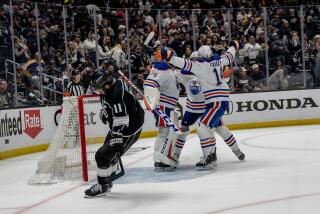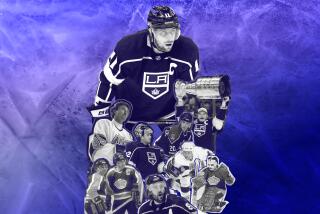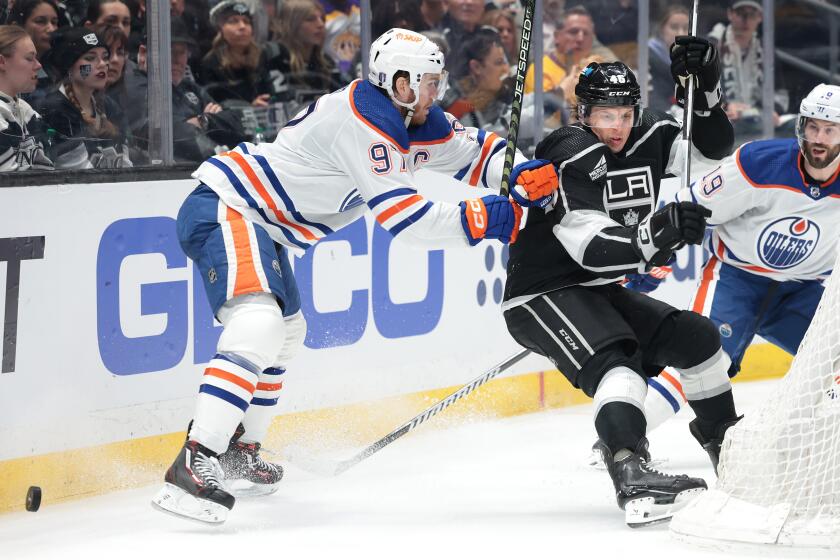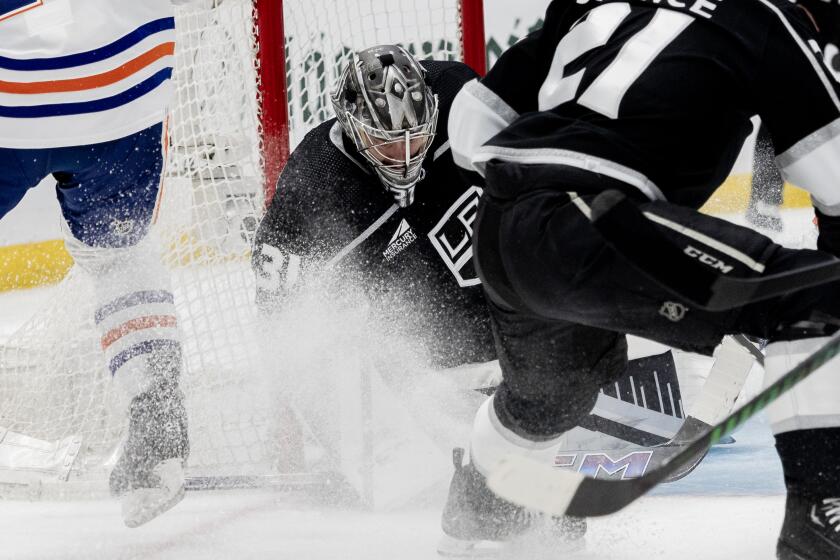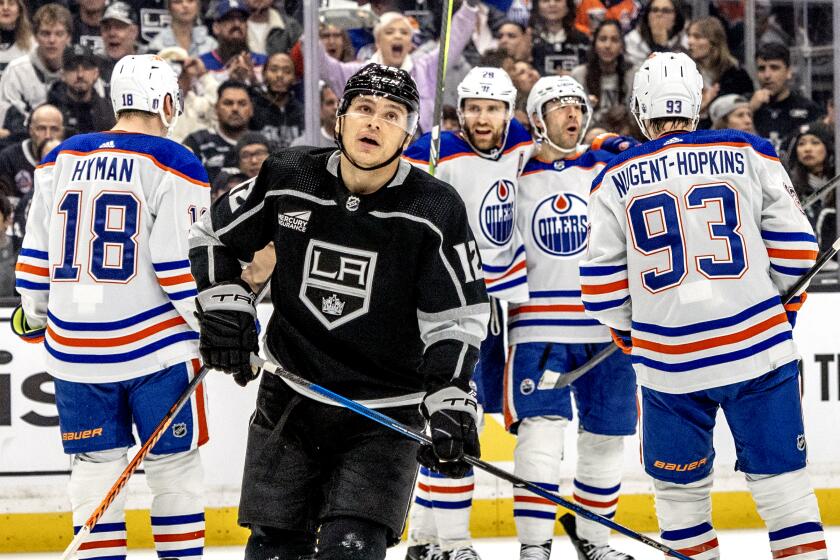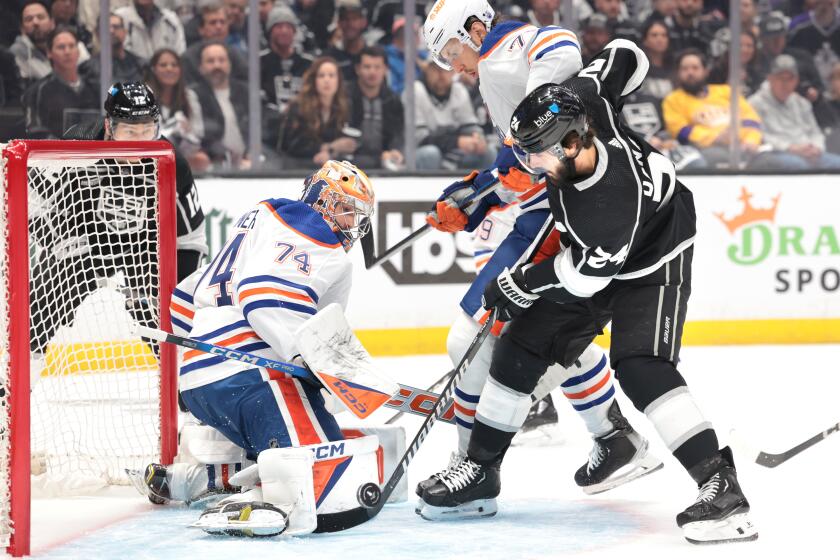So close they could touch it
Cranbrook, Canada
There it is, in the airport parking lot, sitting humbly in a large, blue case. People huddle near it. A woman blushes. A man tells his wife to take a picture. “Honey,” he says, “the Cup is in there.”
Take a break from overpaid athletes, even from their fans. Take a break from the cheating, the gambling, the fighting and the drug abuse. Take a trip with me through rural British Columbia with the Stanley Cup, the trophy given each year for more than a century to the best team in professional hockey. This year, it belongs to the Anaheim Ducks.
When the Ducks bruised and slashed their way to the NHL championship in June and won the Cup, they inherited its madcap tradition, one of the greatest traditions surrounding any trophy in any sport. During the off-season, each player on the championship team gets the Cup for at least one day. He can do with it pretty much whatever he wants.
This year, and in the past, winners have taken the Cup to cities and towns in many parts of the world, including Canada, Sweden, Finland, Japan, Mexico, Russia, the Bahamas, several countries in Europe and to the four corners of the United States.
At this moment, 9 p.m. on a recent Sunday, it is Rob Niedermayer’s turn.
Niedermayer, a Ducks forward, has brought the Stanley Cup to Cranbrook, population 20,000. Here, in Canadian logging country, with its muddy farms and riverbanks and villages, the Cup, a well-worn, waist-high trophy, casts an intoxicating spell. People come in droves to see it. They walk toward it slowly.
They speak reverently about its history and its myths. For a moment here on a quiet evening in the Canadian countryside, there is no cheating or gambling or fighting.
Only awe.
Niedermayer takes the Cup from its blue case. He holds it in his large hands and slogs through wet grass and cow manure to a farm owned by a close friend. Several dozen people surround the trophy, a series of round, silver platforms topped by a large bowl.
Niedermayer puts the Cup down on a bale of hay.
The people stare at it, transfixed. Some break out in song. O Canada, glorious and free. . . .
“There it is,” says Barney Bentall, a musician, who is Niedermayer’s father-in-law. “It’s slightly like the Super Bowl.” Bentall is in a trance. “Only this you can touch, you want to touch it . . . [for Canadians], it’s because of what it means.”
From under his cowboy hat, Bentall ticks off things that make the Stanley Cup special: how the trophy has grown to accommodate the inscribed name of every player on every winning team, how this very trophy sitting on the bale of hay has been handed down from champion to champion for decades.
The lore fascinates him. How this all started in 1892, when Sir Frederick Arthur Stanley bought the Cup for the equivalent of $50 and presented it to the champion Canadian hockey team. How the Cup has been lost, then found; stolen, then recovered. How it travels with a pair of “Cup keepers” -- essentially security guards, though they hardly look the part with their loose jeans, untucked shirts and easy smiles.
How the players have dropped it and banged it. How they have used the trophy as a beer mug, a wine glass and a christening bowl.
It breathes. You can feel it. Rub your finger along the engravings and touch the scratches, the dents and the occasional gashes. The Cup lives, like we do, imperfectly. The misspellings are many. The BOSTON BRUINS are from BQSTQN. The 1980-81 NEW YORK ISLANDERS are the ILANDERS.
One hockey team won the Stanley Cup five years running. The goalie’s name is spelled differently five times.
“It’s just unique,” Bentall says, quietly, his eyes gleaming. The names on it are “guys from small towns . . . guys who take it back home. This trophy has that small-town feel, and that is so much part of our culture. . . .
“This trophy is Canada.”
The next morning, Rob Niedermayer’s brother, Scott, a Ducks defenseman, joins the celebration. Scott’s name is all over the Cup. Before coming to the Ducks, he won three championships with New Jersey.
In years past, when Scott brought the Cup home to Cranbrook -- three stoplights on downtown’s busiest street -- Rob studiously avoided touching it. There is a myth: If a player touches the Cup before winning it, he’s jinxed. He’ll never play on a championship team.
“Finally, I can touch it,” Rob says. “Last night, my wife and I put it right by our bed. I slept touching it.”
Nearly 1,000 people are lined up at the Cranbrook ice rink.
A woman tells me that she has driven eight hours for this. She has tears in her eyes. A man says the hair on his neck is standing straight. Another says it’s like seeing the Holy Grail. Still another, too old to dream of NHL glory, places his hands on the Cup. He says he doesn’t want to wash them. “Just think! Gretzky touched it.”
All week, it is like this. Awe. Amazement. Respect. The Niedermayer brothers take the Cup to a police station, a barbershop, a McDonald’s. They take it on a ski resort chair lift, nestling it between them.
Undeterred by reports of a grizzly bear, they stop by a shallow river, snapping photos. Nearby, a family enjoying a picnic stands up. “I never thought I’d see it,” says the son, barely able to contain his glee. “The Cup! Never.”
A day later, the brothers take the Cup to Fernie, population 5,000, 60 miles east of Cranbrook.
The spell is just as strong.
Half the town, it seems, queues up in front of City Hall. Marty Williams, who works for a mining company, waits an hour to get close. Then he lifts 2-month-old Rhys and gently lets his smiling baby flop into the bowl.
You let your son touch the Cup, now what? I ask.
“Well, yeah,” Williams says. “It’s bad luck to let him touch the Cup if we want him to win it. I guess maybe we jinxed his NHL career. But this moment, it’s good luck for life.”
--
More to Read
Go beyond the scoreboard
Get the latest on L.A.'s teams in the daily Sports Report newsletter.
You may occasionally receive promotional content from the Los Angeles Times.
